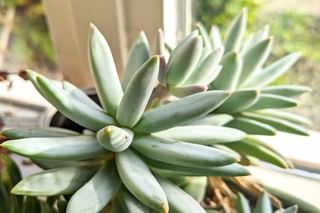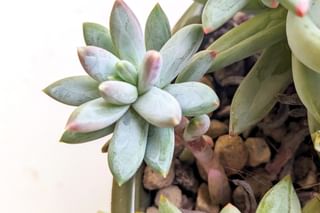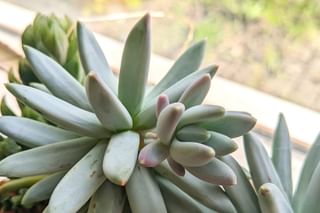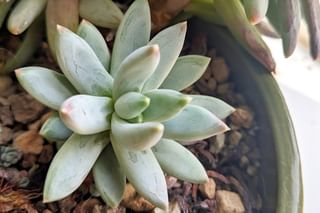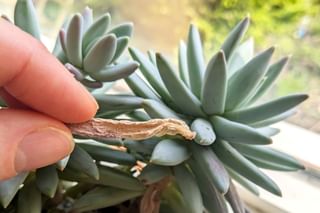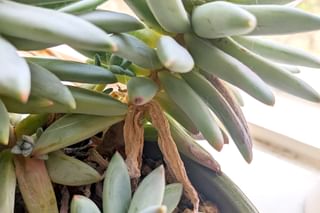How to Take Care of an Echeveria: A Beginner's Guide
Discover the easy care and stylish appeal of Echeveria plants in this plant care guide. Learn how to take care of these popular succulents, known for their resilience and low maintenance needs.
Looking to add a touch of elegance to your home? Have you discovered why Echeveria plants are so great yet? This guide is here to help you take care of your own Echeveria with ease and confidence.
Echeveria plants have become a very popular succulent for many people because of their stylish looks and very minimal care requirements. Not only are these plants very easy to take care of, they're also very tough and can recover from mistakes quite quickly.
In this plant care guide, we'll look at the basics you'll need to know to take care of this amazing succulent. Don't get too intimidated, this plant is very easy to take care of, and prefers it when you forget about it.
Let's get started!
Echeverias in their natural habitat
Echeverias are a diverse group of flowering plants native to semi-desert areas of Central America. Their characteristic fleshy leaves and neat rosette shapes make them easy to spot. These succulents come in various colors and sizes, so there is always a great-looking plant for you. Their relatively small size also makes them perfect for indoor spaces with plenty of sunlight.
Watering schedule
Water is a critical component of Echeveria care, but it's all about finding the balance. Too much can lead to rot, and too little can cause the plant to wither. As we've already learned, Echeverias are native to semi-desert areas, so they thrive when they're dry most of the time.
When the soil is completely dry, you can water them deeply. This means you'll want to water them until the moisture starts to escape from the drainage hole in the bottom of the pot. This ensures deep root hydration. You can also bottom-water your plant, which also helps to hydrate the Echeveria's roots well.
During the active growing seasons of spring and summer, watering your plant every 10-14 days is usually enough for these plants. In the dormant period of fall and winter, water even less, about once a month. The plant will be dormant and won't grow, so you won't have to provide it with too much water.
Signs of overwatering or underwatering
Accidents happen and you could accidentally water your Echeveria too much or too little. If this happens, you'll probably start to see some signs of trouble in your plant. These are the most common ones:
- Overwatering: If the leaves get mushy or translucent and the plant base feels soft, you're likely overdoing it.
- Underwatering: On the flip side, dehydrated Echeverias will exhibit wrinkled leaves or a drooping appearance.
Making sure you water your Echeveria plant on a regular schedule with longer breaks in between is super important to keep it hydrated just right. This way, you avoid overwatering and help it grow nice and healthy by giving it conditions that mimic its natural habitat.
Light and temperature requirements
Echeverias thrive in sunny spots where they can soak up lots of natural sunlight to keep their vibrant colors and encourage beautiful flowers to grow. The plant will turn from a light green into a greenish purple with enough sunlight, so the sunlight can change this plant's color.
Sunlight exposure
For optimal health, provide your Echeveria with plenty of natural sunlight. The amount of sunlight differs a little bit if you growing this succulent indoors and outdoors. Here's the ideal sunlight exposure:
- Indoors: Place your Echeveria near a sunny window where it can receive at least six hours of bright, direct sunlight per day.
- Outdoors: When placed outside, ensure they have a shaded area to retreat from the harsh afternoon sun. Outdoors, the plant doesn't have protection from the windows, so make sure to give it a spot with bright indirect light instead.
Optimal temperature range
With lots of sunlight comes a higher temperature. So it's no surprise that Echeverias prefers slightly higher temperatures between 65℉ and 80℉ (18℃ and 27℃) during the day. However, it also means that you should make sure your plant is never exposed to cold temperatures.
- Cold Spells: Protect your Echeveria from frost, as prolonged exposure to freezing temperatures can cause permanent damage and your plant might have trouble recovering from this.
- Hot Conditions: Higher temperatures are no problem for this plant, as long as it's getting enough water to prevent drying out too quickly. If your Echeveria is growing in very warm temperatures, you might need to water it a little more often.
Finding the right balance of light and temperature helps your Echeveria thrive.
Choosing the right pot and soil
Choosing the perfect pot size and soil type is key to keeping your Echeveria plant healthy and thriving. Make sure the pot lets excess water drain out easily, and use well-draining soil that's perfect for succulents. This way, your Echeveria can spread its roots and grow happily!
Pot size and drainage
When it comes to taking care of plants, remember that the pot size matters a lot. Bigger pots mean less watering, while smaller ones need more attention. Also, the pot size affects how air flows around the roots, which impacts the plant's well-being and growth.
- Pot Size: Choose a pot that's just slightly larger than the plant's root ball to prevent water from lingering in the soil. A pot that's too large will hold onto too much water and will overwater this amazing houseplant.
- Drainage: Always pick a container with drainage holes to avoid waterlogging, which can lead to root rot. By letting the excess soil escape from the pot, the roots aren't sitting in water and oxygen can easily reach your Echeveria's roots.
For most succulents, including the Echeveria, you'll generally want to use a fairly small pot. The soil in these smaller pots doesn't hold onto too much moisture, which helps to prevent root rot.
Ideal soil composition
Pot size isn't everything, you'll also need a special succulent or cactus soil mixture for your Echeveria. Echeverias require well-draining soil to prevent them from sitting in wet soil for too long. Usually, the soil should dry out in 1-2 days. Your Echeveria will have absorbed the moisture it needs to thrive and any excess moisture will have drained to the bottom of the pot.
This is the ideal soil composition for an Echeveria:
- DIY Mix: A mixture of potting soil, coarse sand, and perlite in a 1:1:1 ratio provides excellent drainage. This mixture will drain most of the water to the bottom of the pot right away, only holding onto a little bit of it. Perfect for your drought-loving Echeveria.
- Store-Bought: Succulent or cactus mixtures from garden centers work well too. These mixtures usually contain lots of coarse sand, so they'll drain moisture quickly.
With the right pot size and well-draining soil, you'll give your Echeveria the best chance of success. This environment will keep the plant nice and dry, doesn't provide your plant with a lot of nutrients (which it doesn't need anyway), and looks a lot like the soil it grows in naturally.
Maintenance and propagation
Taking care of Echeverias is important to keep them looking sharp and beautiful. When you look after these plants, you're not just keeping them looking great though, you also get the chance to grow more of them. It's like adding more green to your oasis with each succulent you lovingly nurture.
Pruning and removing dead leaves
Pruning is an easy way to keep your Echeverias neat and prevent diseases. By trimming away dead or overgrown parts, you'll boost their looks and health for the long haul.
Trim any dead leaves as soon as you notice them to maintain the plant's health and appearance. It doesn't matter what time of year it is, as these leaves are a potential source of pests.
Removing these leaves is quite easy, as you can gently pull the leaves off. Dead or dying leaves will usually just fall off without any effort. If not, you can gently twist them off and there shouldn't be much damage to the plant.
Propagation methods
When you're pruning your echeveria, you can also remove one or more healthy leaves and propagate them to get more plants. Propagating Echeveria, like most other succulents, is very easy to do.
There are 2 ways to propagate your Echeveria:
- Offsets: These are the small plants that grow at the base and can be removed and replanted once they're a few centimeters tall.
- Leaf Cuttings: A single leaf laid flat on the soil can sprout roots and a new plant over time. In the spring and summer, you should start to see new roots in 2-3 weeks.
By using care techniques like leaf propagation or stem cutting, you can grow strong and colorful Echeveria plants that'll brighten up your garden or indoor area!
Common issues and solutions
Prevention is key in taking care of your plants! Stay in the know about common issues that might impact your Echeveria succulent. By being aware of things like overwatering, pests, or not enough light, you can keep your Echeveria healthy and happy, whether it's indoors or outdoors.
Pests and diseases
Mealybugs and spider mites are common pests that can harm Echeverias. Keeping an eye out for pests and acting quickly can prevent infestations.
To help your plant fight off these pests, you can use a neem oil spray for the smaller infestations. However, for more severe cases, you may need to isolate the plant and treat it with a horticultural soap or oil.
Isolating any plant with pests is a good idea, as this prevents the pest from spreading to your other houseplants.
Troubleshooting tips
If you still notice signs of problems, but can't find any pests on your Echeveria, perhaps you are dealing with some of these issues:
- Leggy Growth: This is a sign of inadequate sunlight. Move your plant to a sunnier location. The plant won't become compact anymore, but you can "solve" this by propagating the leggy growth on your plant and growing new, compact, Echeverias from this leggy growth.
- Pale Leaves: If your Echeveria is not receiving enough light, its usually vibrant colors may become pale or greenish. This is a very clear sign your plant needs more light.
- Black Spots: This may be indicative of overwatering. Adjust your watering schedule and take action if the spots grow. If the soil is wet, make sure to repot your plant into fresh and dry soil to prevent (further) root rot. If you notice any rotting roots while repotting your plant, make sure to trim them.
Keep an eye on your Echeveria plant by watching for any color, texture, or growth changes. Being proactive in spotting issues early will keep your plant vibrant and healthy in the long run.
Conclusion
Taking care of an Echeveria plant can be such a rewarding hobby! It brings joy to people of all gardening levels. These cool succulents do best with some sunlight, well-draining soil, and a little watering. Watch your Echeveria grow into a stunning addition to your space, indoors or out. Enjoy nurturing it and seeing how it transforms over time!
Remember the essentials:
- Water infrequently but deeply.
- Provide plenty of sunlight and watch for signs of light deficiency.
- Choose the right pot and soil for excellent drainage.
- Perform regular maintenance and enjoy propagating new plants.
- Stay vigilant against pests and diseases.
By sticking to these easy tips, your Echeveria will thrive and keep bringing you joy all year round.
Thank you for reading this post! I hope it helps you to keep your plants healthy and beautiful! If you're looking for more guides on specific plants, you can always request a plant guide to get a guide for the plant you have trouble with.
Test your plant care knowledge
Quiz completed!
Want to learn more? Sign up for my newsletter to receive free tips in your inbox!
Sign up now!